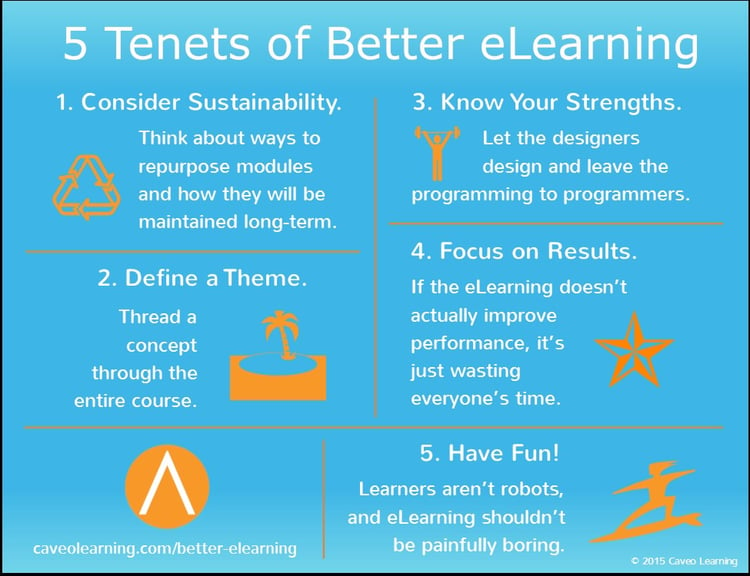Posted by Jeff Carpenter ● July 7, 2015
Learning Leaders, It's Time to Develop Better eLearning
 Remember when eLearning used to be elegant, beautiful, and fun? When a team would be pulled together to come up with program learning objectives, themes, visuals, and interactive components? They would debate ways to make the learning more immersive, interactive, and impactful to the learners.
Remember when eLearning used to be elegant, beautiful, and fun? When a team would be pulled together to come up with program learning objectives, themes, visuals, and interactive components? They would debate ways to make the learning more immersive, interactive, and impactful to the learners.
The golden era of eLearning seems to be behind us, and the overwhelming homogenization of content has been in full drive over the last decade or so. Why is that?
Many of us like to think that it was the advent of WYSIWYG eLearning authoring tools that relegated eLearning to the commodity trash heap, but that would only be partially correct.
We need to look deeper into why those tools came about and take a long look in the mirror. This is a systemic problem that we have as an industry. Whenever we see the potential power of learning tools, we try to control the design and development process from beginning to end. We go to classes to learn how the tools work and quickly realize that they are difficult, time consuming, and challenging to master. Graphics development, interaction, and programming require a skill set that many learning and development professionals do not possess. These skill gaps don’t allow us to achieve the same results we had accomplished as part of the larger team, so we begin to make tradeoffs and allowances trying to justify our lack of capability as not as important to the learning process.
We start to contort the notion of interactivity as nothing more than popups, rollovers, and PowerPoint animation. Eventually, we convince ourselves that it’s all about the instructional design, and that drag-and-drop or multiple-guess questions are just as powerful of a learning technique as immersive simulations or case-based learning. Let’s be honest, it’s not… it’s not even close.
End users are ultimately the victims of this slow decline in interactive and instructional quality. The race to conquer eLearning design and development has left users cringing each time they are required to attend another online course. Clicking the Next button becomes their only lifeline to the merciful ending of the knowledge check.
We Can Develop Better eLearning
So how can we as learning leaders fix this mess that our industry has made for itself? We need to remember these five tenets of eLearning.
1. Not all eLearning is disposable learning.
Spend time thinking about how a given training deliverable will be used beyond its initial implementation. Learning modules typically have useful lives beyond their original intent. Are there elements that can be repurposed for reinforcement, new hires, or other curricula? Keep learning sustainability in mind, too.
2. Define the theme or concept.
Too often, instructional designers get doe-eyed coming up with elaborate themes or concepts that fall very short. It doesn’t have to be about pirates or Greek gods. The theme can be something simple, but it needs to be threaded through the entire module. As an example, while I was trying to come up with a theme for a company’s first eLearning module, I kept hearing that the solution needed to be classroom training... so the module was designed with a college professor in front of a classroom of people (the user was in the back row).
3. Remember your strengths.
If you are a rock star instructional designer, be that. Let other learning and development professionals come to the table to provide support in their areas of expertise. What you will find is that the cost and time that it takes is lower, with higher quality, than if you did it on your own. So engage a programmer and graphic artist to make your vision come to life.
4. Focus on results.
My litmus test of any good eLearning module is simple: Does it allow the user to perform the task, activity, decisions, etc., that is expected of them back on job? If it doesn’t, then what are you providing to the users has limited impact on results—and ultimately little value.
5. Have some fun.
The other litmus test for effective eLearning is simple: People aren’t robots, and so eLearning shouldn’t be boring and painful. Have some fun with appropriate humor or gags. It doesn’t need to be slapstick to be funny; instead, make it subtle, like the name of a character or something on a shirt or nametag.
Let’s call this the beginning of a renaissance to times when people would throw rose petals at your feet and beg to take another module you were producing. OK, that's probably a little much... but to not have them sigh and frantically click the Next button would be a great start.

Topics: Instructional Design, eLearning
